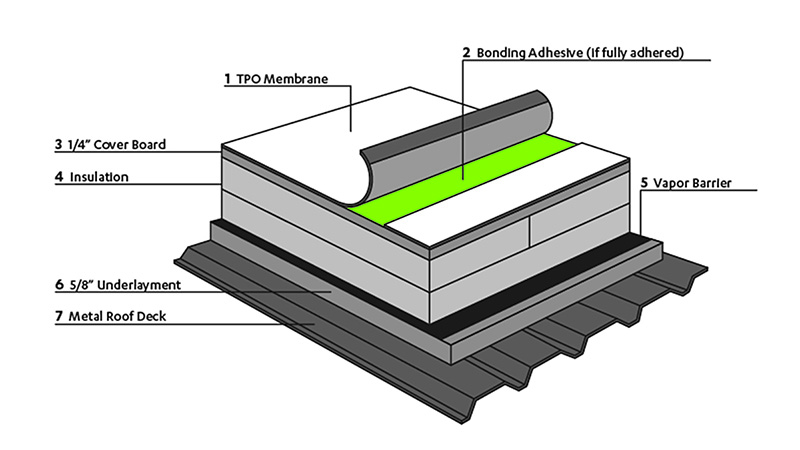When it comes to roofing solutions, TPO (Thermoplastic Olefin) over metal roofs has gained significant attention due to its exceptional durability, energy efficiency, and cost-effectiveness. TPO roofing systems provide an effective and long-lasting protective barrier, ensuring the integrity of the underlying metal roof while offering numerous benefits. This article explores the advantages of TPO over metal roofs and why it has become a preferred choice for many property owners and roofing professionals.

The Benefits of TPO Over Metal Roofing
A Brief Overview
TPO, short for Thermoplastic Olefin, is a synthetic single-ply roofing membrane commonly used in commercial and residential applications. It is renown for its remarkable resistance to ultraviolet (UV) radiation, ozone, and chemical exposure. The combination of TPO’s flexibility and strength makes it an ideal choice for protecting metal roofs against various weather elements and extending their lifespan.
Enhanced Durability and Weather Resistance
One of the primary advantages of TPO over metal roofing is its outstanding durability and ability to withstand extreme weather conditions. TPO membranes possess excellent puncture resistance, making them highly resistant to hail, debris, and foot traffic. Additionally, TPO’s inherent ability to reflect UV rays helps reduce heat absorption, preventing premature aging and deterioration of the underlying metal roof.
Superior Energy Efficiency
Energy efficiency is a crucial consideration for any roofing system, and TPO over metal roofs excels in this aspect. The reflective properties of TPO membranes result in significant energy savings by minimizing heat transfer into the building during hot summers. This reduces the workload on cooling systems and lowers energy consumption, ultimately leading to reduced utility bills and a smaller carbon footprint.
Cost-Effectiveness and Installation Ease
Choosing TPO over metal roofing can provide cost savings both in the short and long term. TPO membranes are comparatively less expensive than other roofing materials, making them an affordable option for property owners. Moreover, the installation process is relatively quick and straightforward, which further reduces labor costs. TPO’s lightweight nature also minimizes structural stress, making it suitable for retrofit projects.
TPO Over Metal Roof: Installation Process
Preparing the Metal Roof Surface
Before the installation of TPO membranes, proper preparation of the metal roof surface is essential. This includes cleaning the surface thoroughly, removing any debris, rust, or loose material, and repairing any damaged areas. A smooth and clean surface ensures optimal adhesion and longevity of the TPO membrane.
Applying TPO Membrane
Once you prepare the metal roof, you can apply the TPO membrane. The membrane is available in rolls that are rolled out and mechanically fastened or adhered to the metal roof surface using specialized adhesives. The seams between the TPO sheets are heat-welded to create a continuous and watertight barrier. The installation process requires precision and expertise, and it is recommended to hire professional roofing contractors for best results.
Conclusion: TPO Over Metal Roof – A Wise Choice
TPO over metal roofs offers an efficient and cost-effective solution for property owners seeking to enhance the performance and longevity of their roofs. With its exceptional durability, weather resistance, energy efficiency, and ease of installation, TPO has become a preferred choice in the roofing industry. The combination of TPO’s UV resistance and reflective properties helps maintain a comfortable indoor environment while reducing energy consumption. Whether for new construction or retrofit projects, TPO over metal roofing provides a reliable and sustainable roofing solution.
Conclusion
In conclusion, TPO over metal roofs not only safeguards the underlying metal structure but also provides numerous benefits that contribute to a more efficient and sustainable building. As the demand for eco-friendly and energy-efficient roofing options continues to rise, TPO membranes have proven to be a reliable choice for property owners looking to enhance their roofing system’s performance. By opting for TPO over metal roof installation, one can enjoy long-term durability, reduces energy costs, and peace of mind knowing their property is well-protected from the elements.



Leave a Reply